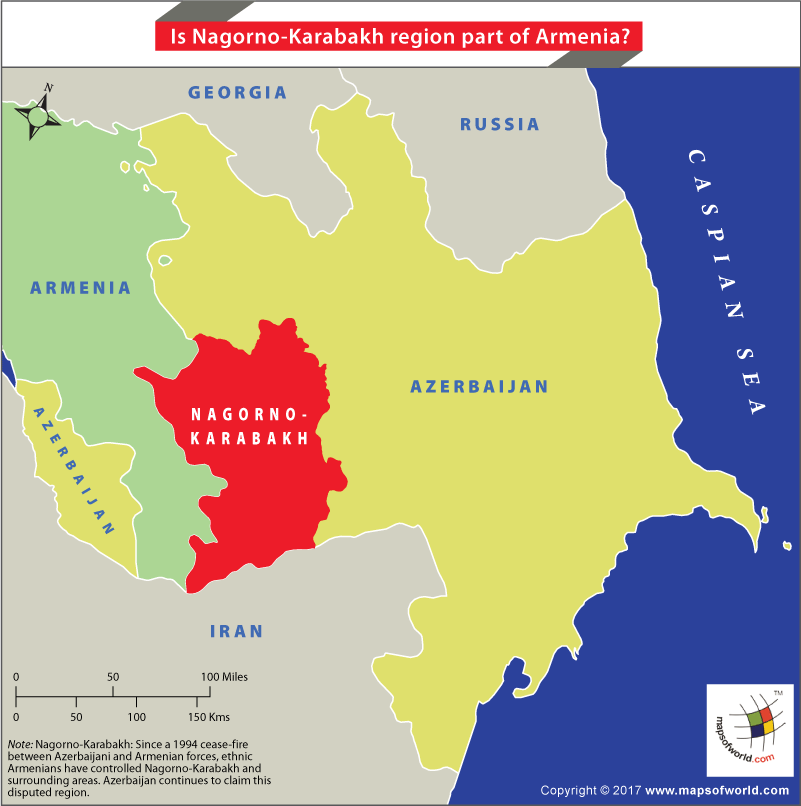Is Nagorno-Karabakh region part of Armenia?

No. Nagorno-Karabakh is part of Azerbaijan, forcefully controlled by the ethnic Armenian majority, with financial and military support from Armenia.
Nagorno-Karabakh is a landlocked mountainous region within Azerbaijan, covering around 1,700 sq miles. Historically, people of Christian Armenian descent have lived in the region along with Muslim Turkic Azeris and other communities. The Armenians have been in majority for a long time.
The present dispute over Nagorno-Karabakh has its roots in the aftermath of the Russian Revolution in 1917. Regions of Armenia and Azerbaijan were already fighting to gain territorial control over the Karabakh area. Under Josef Stalin’s supervision, the Nagorno-Karabakh Autonomous Oblast was set up on 7 July, 1923, with Azerbaijan getting jurisdiction over the territory.
Through the Soviet era, infighting between the Armenians and Azeris remained suppressed. It was on 13 February, 1988, when the Soviet Union was undergoing internal turmoil, that the first clash between Armenians and Azeris took place. Consequently, the Armenians who lived in Azeri dominated areas fled their homes, and the same happened with Azeris, who fled Armenian dominated villages.
It is estimated around 30,000 people died in clashes that saw Armenians taking control of the Karabakh region. They further extended their occupation to areas outside of Karabakh that was part of Azerbaijan.
With the break-up of the Soviet Union in 1991, Armenians of Karabakh region declared Nagorno-Karabakh an independent republic, a position that was neither officially recognized by Armenia nor the international community. But Armenia continued supporting the local Armenians with military and financial resources.
By the time Russia brokered a peace between the fighting groups in 1994, over a million had fled the region which helped Armenians take control over the Karabakh region, along with large parts of Azerbaijan’s territories.
Armenia has continued to back local Armenians with military hardware, who have been sporadically clashing with Azeri forces since 1994. The Organization for Security Co-operation in Europe (OSCE) led by Russia, US and France has been trying to get the disputing parties to come to a settlement but have failed.
International condemnation
In 1993, the UN Security Council has condemned Armenia’s occupation of Azerbaijan’s territories and its persecution of local Azeris vide Resolutions 822, 853, 874 and 884.
On 25 January 2005, the Parliamentary Assembly of the Council of Europe (PACE) adopted Resolution 1416 condemning Armenia-backed forces for ethnic cleansing actions against the Azeris.
On 17 May, 2007, the Foreign Ministers Conference of the Organization of Islamic Conference (OIC) adopted a Resolution 7/34-P calling Armenia’s occupation of Azerbaijani territory illegal and condemning Armenian action against ethnic Azeris, stating it was a crime against humanity.
On 14 March, 2008, UN General Assembly passed Resolution 62/243 calling for Armenia to immediately and unconditionally withdraw from Azerbaijan’s territory.
On 26 January, 2016, PACE adopted Resolution 2085 once again condemned Armenia and called for its immediate withdrawal from Azerbaijan.
Armenia has not taken any action to withdraw despite several interventions by world leaders.
Between 1 and 4 April, 2016, Nagorno-Karabakh Defense Army, supported by Armenian military, clashed with Azerbaijan Armed Forces, with both sides using heavy weapons. Over 350 military and civilians were reported dead.
The Nagorno-Karabakh dispute remains unresolved with Armenia continuing to occupy Azerbaijan territory.
Related Maps:


